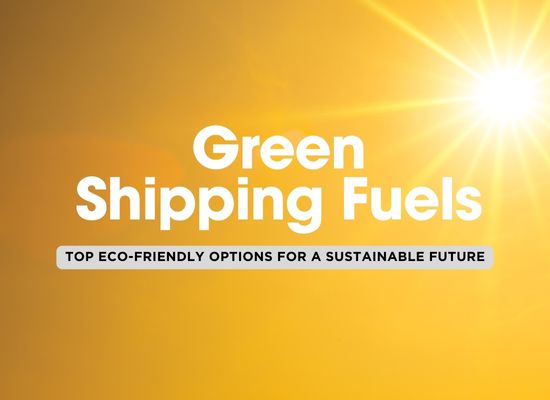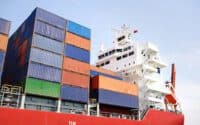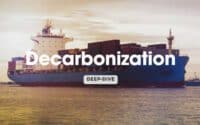The Top 5 Greenest Shipping Fuels

As the industry navigates toward a greener future, innovative fuel solutions are transforming how ships power through the seas. From cutting-edge wind and solar technologies to promising new fuels like hydrogen and ammonia, these green alternatives are reducing emissions and paving the way for sustainable shipping. Here’s a closer look at the top five eco-friendly options fueling the next generation of cleaner, smarter vessels.

#1 Wind Propulsion Systems 🌊🌬️
Wind propulsion technology has evolved far beyond traditional sails. Modern wind-assisted systems are designed for efficiency and ease of integration with existing vessels. Here are the primary types:
- Rotor Sails
Description: Rotor sails, also known as Flettner rotors, are tall, spinning cylinders installed vertically on deck. They utilize the Magnus effect, where spinning generates lift, pushing the vessel forward. Rotor sails are effective even with moderate winds, making them a popular choice for fuel savings.
Pros: Significant fuel savings (up to 10-20%), effective at low speeds, can be retrofitted onto existing ships.
Cons: Require deck space, initial installation cost, optimal in specific wind conditions.
Ideal for: Commercial cargo ships, tankers, and bulk carriers with ample deck space. - Kite Sails
Description: Kite sails are large kites deployed ahead of the ship to harness strong winds. These kites capture wind at higher altitudes, where it’s generally stronger, and help pull the vessel forward, reducing engine load.
Pros: Cost-effective, reduces fuel consumption significantly, easy to install and control, minimal deck space needed.
Cons: Less effective in low wind conditions, complex operation, requires specialized handling.
Ideal for: Medium to large vessels, especially for transoceanic routes where high-altitude winds are consistent. - Rigid and Soft Sails
Description: Modern rigid and soft sails are specially engineered for durability and high performance, often using automated adjustments to maximize wind capture. These can include wing sails, which resemble airplane wings and offer excellent aerodynamic efficiency.
Pros: Fully renewable, adaptable to various wind speeds, significant fuel savings, zero emissions.
Cons: Requires sufficient deck space, higher maintenance costs, limited effectiveness in calm conditions.
Ideal for: Bulk carriers, ferries, and passenger vessels with large deck areas.
Key Benefits 🌍💨
The advantages of wind propulsion go beyond reducing greenhouse gas emissions:
- Fuel Cost Savings
Ships with wind-assisted systems have seen fuel savings between 5-20%, depending on route and wind conditions. This makes wind power especially valuable as fuel prices fluctuate. - Emission Reductions
Wind power contributes directly to lowering carbon, sulfur, and nitrogen oxide emissions. Using wind for propulsion also reduces a ship’s dependency on fuel oil, cutting its carbon footprint significantly. - Compliance with Regulations
As environmental regulations become stricter (such as IMO 2030 targets), wind propulsion helps shipowners comply by reducing emissions and avoiding penalties. - Enhanced Sustainability Image
Companies using wind propulsion can boost their eco-friendly image, appealing to environmentally conscious clients and partners. This can improve brand reputation and open up new business opportunities.
Challenges & Limitations 🔧⚙️
While promising, wind propulsion has its hurdles:
- Inconsistent Wind Conditions
Wind strength and direction vary, making it an inconsistent energy source on some routes, especially near coastal or tropical regions. - Initial Investment
Wind systems can require a considerable upfront cost, especially if retrofitting an existing ship. However, savings on fuel can offset these costs over time. - Operational Complexity
Crew members need training to operate and maintain wind systems effectively, particularly for systems like kite sails or rotor sails.
Future Potential 🚀🌎
As technology advances, wind-assisted propulsion is likely to become even more efficient and accessible. Research is underway to develop more compact and cost-effective systems, making wind an even more feasible option for reducing shipping emissions. For now, wind propulsion is one of the cleanest, most immediate ways to green maritime operations, bringing the industry closer to sustainable shipping targets.
#2 Solar Power ⚡🌞
Ships can use solar power in several innovative ways to reduce their carbon footprint and enhance operational efficiency. Here’s how:
- Onboard Electrical Systems
Description: Solar panels can generate electricity to power a ship’s onboard systems, such as lighting, navigation, and communication equipment, lowering the vessel’s reliance on fuel for these essentials.
Pros: Reduces fuel use, ideal for powering continuous small loads, low-maintenance.
Cons: Limited to non-propulsive uses, requires sunny weather.
Ideal for: All types of vessels, particularly those in sunny regions. - Auxiliary Power for Hybrid Systems
Description: In hybrid propulsion setups, solar energy can reduce engine load, conserving fuel and extending the life of main engines. Solar power is particularly effective in hybrid systems, helping ships run more efficiently with fewer emissions.
Pros: Works well with battery storage for night use, cuts fuel costs, supports peak power needs.
Cons: Limited by weather and sunlight availability, initial setup costs.
Ideal for: Large vessels with battery storage, ferries, and short-sea shipping routes. - Solar-Only Vessels
Description: While not common in commercial shipping, small solar-only vessels are used for specific purposes, like eco-friendly tourist boats or research missions. These vessels rely entirely on solar panels and batteries for power, achieving zero emissions.
Pros: Fully emission-free, no fuel required, ideal for eco-tourism and research.
Cons: Limited power and range, requires consistent sunlight, not suitable for large commercial ships.
Ideal for: Small vessels, lake or river tourism boats, environmental research.
Key Benefits 🌍☀️
Solar energy offers several compelling benefits for shipowners and the environment:
- Emission Reduction
By offsetting fuel needs, solar power directly reduces carbon dioxide, sulfur, and nitrogen oxide emissions, aligning with global efforts to lower shipping’s environmental impact. - Cost Savings
Although solar panels require an initial investment, they offer substantial fuel savings over time. With minimal maintenance and operational costs, solar panels can contribute to lower operational expenses for years to come. - Energy Independence
Solar power provides an alternative energy source, reducing reliance on fossil fuels and offering some energy autonomy. This can be particularly beneficial in remote regions or during long voyages. - Sustainability Image
Vessels that incorporate solar energy can market themselves as eco-friendly, appealing to companies and clients seeking greener supply chain options. This sustainable approach also aligns with industry standards like IMO 2030 and 2050 targets.
Challenges & Limitations 🌦️⚙️
Despite its benefits, solar energy has some limitations when it comes to powering ships:
- Weather Dependency ☁️
Solar panels depend on sunlight, which can be unreliable in cloudy or stormy conditions. Additionally, ships operating in northern latitudes or during winter seasons will have reduced solar power availability. - Energy Density and Storage
Solar panels currently don’t generate enough power to sustain large vessels over long distances. Battery storage can help, but it requires significant space and adds weight, limiting practicality for large ships. - High Initial Investment
Solar panel installations can be costly, and while savings accrue over time, the upfront expense can be a barrier. This is particularly true for retrofitting older vessels.
Future Potential 🚀🌞
The role of solar power in shipping will only grow as solar technology advances. Higher-efficiency panels, better battery storage solutions, and innovative deployment methods (like flexible or foldable solar panels) are making solar power more viable for maritime applications. Solar-assisted vessels are increasingly common, especially in hybrid systems, and will continue to play a crucial role as the industry strives toward zero-emission goals.
#3 Green Hydrogen 🚢⚡
Green hydrogen can be used in two main ways to power ships:
- Hydrogen Fuel Cells
Description: Hydrogen fuel cells generate electricity by combining hydrogen and oxygen, producing water as the only byproduct. This electricity powers the ship's propulsion systems and other onboard equipment, creating a fully emission-free operation.
Pros: Zero emissions, high efficiency, quiet operation, scalable for large vessels.
Cons: High initial cost, complex fuel storage requirements, infrastructure limitations.
Ideal for: Ferries, cruise ships, and cargo vessels where emissions regulations are strict. - Hydrogen Combustion Engines
Description: Hydrogen can also be burned in modified combustion engines, releasing zero carbon emissions. This method has lower efficiency than fuel cells but is simpler to integrate with existing engines.
Pros: Carbon-free combustion, faster adaptation for existing fleets, compatible with large ships.
Cons: Less efficient than fuel cells, requires high-pressure storage, NOx emissions must be controlled.
Ideal for: Bulk carriers, tankers, and ships operating in regulated emission zones.
Key Benefits 🌱💧
Green hydrogen brings significant environmental and operational benefits to shipping:
- Zero Carbon Emissions
As a zero-emission fuel, hydrogen offers a solution to the maritime industry’s carbon footprint, helping ships comply with increasingly strict environmental standards like the IMO 2030 and 2050 targets. - Renewable Energy Source
Produced using renewable electricity, green hydrogen doesn’t rely on fossil fuels, making it a sustainable energy option with the potential for large-scale production. - High Energy Density
Compared to other green fuels, hydrogen has a high energy density by weight, meaning less fuel is needed to travel long distances. This makes it particularly appealing for long-haul, large-capacity vessels. - Minimal Environmental Impact
Unlike biofuels, which depend on agricultural resources, or LNG, which can produce methane slip, hydrogen’s production and use have minimal direct environmental impacts, making it one of the greenest options available.
Challenges & Limitations 🛠️⚠️
Green hydrogen is promising, but the transition presents several challenges:
- Storage and Transport Issues
Hydrogen is a low-density gas that must be compressed or liquefied for storage, which requires specialized tanks and adds significant weight. This creates logistical challenges, especially for long-haul voyages. - High Production Cost
Green hydrogen production is expensive, mainly due to the cost of renewable energy and electrolysis equipment. Scaling production to meet global shipping demand will require substantial investment. - Infrastructure Development
A limited number of ports have hydrogen refueling stations, which restricts where hydrogen-powered ships can operate. Expanding this infrastructure will be essential for global adoption. - Energy Conversion Efficiency
While hydrogen fuel cells are efficient, the process of producing, compressing, and transporting hydrogen can reduce overall energy efficiency, compared to using renewable electricity directly.
Future Potential 🚀🌍
Hydrogen is widely considered a "fuel of the future" for shipping. As renewable energy costs decrease and hydrogen production becomes more efficient, the feasibility of green hydrogen will only increase. Significant investments are being made globally to develop hydrogen infrastructure, and research into hydrogen storage and safety is accelerating. For ships, green hydrogen offers the potential for truly sustainable, zero-emission operations, making it one of the most promising green energy sources for maritime shipping.
#4 Green Ammonia ⚗️🌐
Green ammonia is quickly emerging as a frontrunner in the race to decarbonize shipping. Produced from renewable hydrogen and nitrogen, ammonia is a carbon-free fuel that emits no CO₂ during combustion, making it an attractive option for the maritime industry. With its high energy density and established infrastructure in industries like agriculture, ammonia is considered especially suitable for large cargo ships, tankers, and bulk carriers. However, there are challenges, such as toxicity and safety, that need to be addressed for ammonia to become a mainstream maritime fuel. Here’s a deeper look into the benefits, applications, and hurdles associated with ammonia as a green fuel for shipping.
How Ammonia Works as a Marine Fuel ⚡⚗️
Ammonia can be used in shipping in two main ways, depending on the vessel’s technology and route requirements:
- Combustion Engines Modified for Ammonia
Description: Ammonia can be burned in modified internal combustion engines, providing a straightforward path for large ships to switch to a carbon-free fuel. While ammonia burns without CO₂ emissions, it does release nitrogen oxides (NOx), which need to be managed through after-treatment systems.
Pros: Carbon-free combustion, relatively high energy density, adaptable for large vessels.
Cons: NOx emissions, toxic handling requirements, limited infrastructure for refueling.
Ideal for: Large cargo ships, tankers, and bulk carriers. - Fuel Cells with Ammonia as Hydrogen Carrier
Description: Ammonia can also act as a carrier for hydrogen, which is released onboard and then used in hydrogen fuel cells to generate electricity. This approach is currently in early stages of development but could offer a clean, efficient solution with zero emissions beyond water vapor.
Pros: Carbon-free, high efficiency, minimal pollution when paired with fuel cells.
Cons: Requires advanced technology for hydrogen release, higher cost, toxicity concerns.
Ideal for: Future technology development, particularly for ships operating in strict emission-control areas.
Key Benefits 🌱⚗️
Ammonia offers several compelling benefits for maritime shipping, particularly in terms of emissions reduction and energy efficiency:
- Zero Carbon Emissions
Ammonia’s main advantage is its carbon-free combustion, which significantly reduces greenhouse gas emissions. While NOx can be produced, after-treatment systems can mitigate this issue, making ammonia one of the most viable zero-carbon fuels available. - Established Infrastructure
Ammonia is already widely produced and transported globally for agriculture, giving it an existing distribution and storage infrastructure that could support its transition into shipping fuel. - High Energy Density
Ammonia has a high energy density by volume, allowing ships to carry sufficient fuel for long-distance routes. This makes it suitable for large vessels and transoceanic shipping. - Compatibility with Existing Technology
Ammonia can be used in both modified internal combustion engines and fuel cells, allowing ships to adopt it without a complete overhaul of their propulsion systems.
Challenges & Limitations 🚧⚠️
Despite its promise, ammonia as a marine fuel presents several challenges:
- Toxicity and Safety Concerns
Ammonia is highly toxic and corrosive, requiring careful handling and specialized storage tanks to prevent leaks or spills. Crew members need special training, and ships must be equipped with safety measures to handle ammonia safely. - NOx Emissions 🌫️
While ammonia itself doesn’t produce CO₂, it does produce nitrogen oxides (NOx) when burned, which are harmful pollutants. Advanced catalytic systems are required to reduce NOx emissions, adding to the cost and complexity of using ammonia. - Limited Refueling Infrastructure
Although ammonia has an established infrastructure in other industries, port infrastructure for refueling ships with ammonia is still limited. Significant investment is needed to expand this infrastructure to make ammonia a practical option for global shipping. - High Production Cost 💸
Currently, green ammonia production is more expensive than fossil fuels, primarily because it relies on renewable hydrogen. However, costs are expected to decrease as renewable energy and green hydrogen production scale up.
Future Potential 🚀⚗️
Ammonia is seen as a strong contender for decarbonizing the maritime industry. With ongoing research and development to improve handling safety, reduce NOx emissions, and build port infrastructure, ammonia could become a widely adopted fuel for large vessels by the 2030s. Its scalability, energy density, and carbon-free combustion make it ideal for long-distance shipping, and as the industry ramps up investment, ammonia’s costs and safety measures will likely become more manageable.
#5 Liquefied Natural Gas (LNG) 🌊🛢️
Liquefied Natural Gas (LNG) has become a popular choice as the shipping industry seeks to reduce its carbon footprint. While LNG is not a zero-emission fuel, it produces significantly lower emissions than traditional heavy fuel oil, making it a “bridge” fuel as the industry develops and adopts fully renewable solutions. LNG is versatile and already has an established infrastructure, making it feasible for a wide range of vessels. However, challenges such as methane slip and limited refueling stations in some regions still need addressing. Here’s an in-depth look at how LNG is used in shipping, its benefits, and the obstacles it faces as a sustainable fuel option.
How LNG Works in Shipping ⚡🛢️
LNG can be used in various ship types and propulsion systems to reduce emissions compared to conventional marine fuels:
- Dual-Fuel Engines
Description: Dual-fuel engines allow ships to operate on either LNG or diesel, providing flexibility and reducing overall emissions. This is the most common approach for LNG-powered vessels, as it enables the ship to switch fuels as needed.
Pros: Lower carbon emissions, fuel flexibility, compatible with existing engine technology.
Cons: Requires complex engine systems, higher maintenance, not fully zero-emission.
Ideal for: Cargo ships, tankers, and ferries operating in regions with LNG infrastructure. - Pure Gas Engines
Description: Pure gas engines are optimized for LNG, offering even greater emissions reductions compared to dual-fuel engines. This setup is generally chosen for vessels operating exclusively in areas where LNG refueling infrastructure is available.
Pros: Higher efficiency, lower emissions, optimized for LNG use.
Cons: Requires reliable LNG refueling access, higher installation cost, potential methane slip.
Ideal for: Ferries, cruise ships, and short-sea vessels with consistent LNG supply routes.
Key Benefits 🌱🛢️
LNG offers several environmental and operational benefits that make it an attractive fuel for reducing maritime emissions:
- Lower Carbon Emissions
LNG produces approximately 20-30% less CO₂ than heavy fuel oil and virtually eliminates sulfur oxides (SOx) and particulate matter, helping vessels comply with emissions regulations and improve air quality in port areas. - Established Infrastructure
LNG refueling stations are available in major ports around the world, allowing ships to refuel relatively easily. This established infrastructure makes LNG more immediately accessible than some other alternative fuels. - Fuel Flexibility
Dual-fuel engines provide the flexibility to switch between LNG and diesel, giving shipowners the option to use LNG when refueling stations are available and rely on diesel otherwise. - Lower Operational Costs
Although LNG requires an initial investment in specialized engines, it can lower long-term operational costs due to its higher energy efficiency and reduced emissions-related penalties.
Challenges & Limitations 🛠️⚠️
LNG is a transitional fuel with benefits, but it comes with specific challenges that limit its role as a fully sustainable solution:
- Methane Slip
One of the main drawbacks of LNG is methane slip, where unburned methane (a potent greenhouse gas) escapes during combustion. This undermines LNG’s environmental benefits, though new engine designs are being developed to minimize methane emissions. - Not Carbon-Free
While LNG reduces CO₂ emissions compared to traditional fuels, it is not a zero-emission option. As stricter emissions targets approach, LNG may eventually be replaced by greener alternatives, such as hydrogen or ammonia. - High Initial Investment
Converting or building vessels to operate on LNG requires a substantial upfront investment, which can be a barrier for smaller operators or older fleets. - Infrastructure Limitations in Some Regions
Despite its established presence in major ports, LNG refueling is still limited in some parts of the world. This restricts its use to certain routes or requires vessels to carry larger LNG tanks, reducing cargo capacity.
Future Potential 🚀🛢️
LNG will likely remain a key fuel in shipping over the next decade as the industry develops fully renewable alternatives. With ongoing advancements to reduce methane slip and expand infrastructure, LNG can serve as a practical bridge to a zero-emission future. The International Maritime Organization (IMO) recognizes LNG as a viable near-term solution to meet current emissions regulations, and its widespread infrastructure supports its role as a transitional fuel. However, as zero-carbon fuels become more accessible, LNG may gradually phase out in favor of fully renewable options like hydrogen and ammonia.
The path to sustainable shipping is filled with exciting advancements, each bringing us closer to a carbon-free future on the seas. As shipowners and operators embrace these greener options, they’re not only meeting global regulations but also championing a cleaner planet. With every turn of a rotor sail and spark of renewable hydrogen, the shipping industry sails confidently toward a more sustainable horizon.
Table Summary
| ShipUniverse: Top 5 Greenest Shipping Fuels | |||
| Fuel Type | Description | Pros | Cons |
|---|---|---|---|
| Wind Propulsion | Using sails, rotor sails, and kites to harness wind power for emission-free propulsion, especially effective on long-haul routes with consistent winds. |
- Zero emissions - Reduces fuel consumption significantly - Low maintenance with modern sails |
- Requires specific wind conditions - Initial installation cost - Not suitable for calm or tropical routes |
| Solar Power | Using solar panels to power onboard systems or assist propulsion, ideal for hybrid setups and smaller vessels. |
- Emission-free and renewable - Lowers fuel costs over time - Minimal maintenance |
- Weather-dependent - High initial cost - Limited power density for large ships |
| Green Hydrogen | Zero-emission fuel produced by renewable energy, used in fuel cells or combustion engines; emits only water vapor. |
- Pure zero emissions - High energy density - Sustainable and renewable |
- Expensive production costs - Needs specialized storage - Limited infrastructure |
| Green Ammonia | Carbon-free fuel derived from renewable hydrogen, ideal for large ships but requires careful handling due to toxicity. |
- No CO₂ emissions - High energy density - Established industry infrastructure |
- Highly toxic - Emits NOx; needs after-treatment - High production cost |
| Liquefied Natural Gas (LNG) | A cleaner fossil fuel alternative that reduces CO₂, SOx, and particulate emissions, though not carbon-free. |
- Lower emissions than oil - Established port infrastructure - Can reduce fuel costs |
- Methane slip can undermine benefits - Still a fossil fuel - High initial investment |

Do you have a Maritime Product or Service that may be of interest to Shipowners? Tell us about it here!
Do you have feedback or insights? Please reach out to editor @ shipuniverse.com



